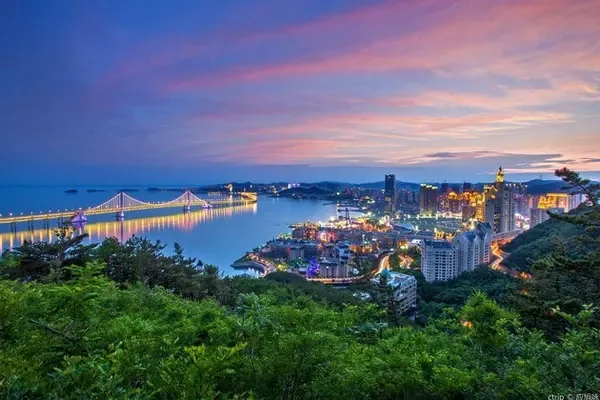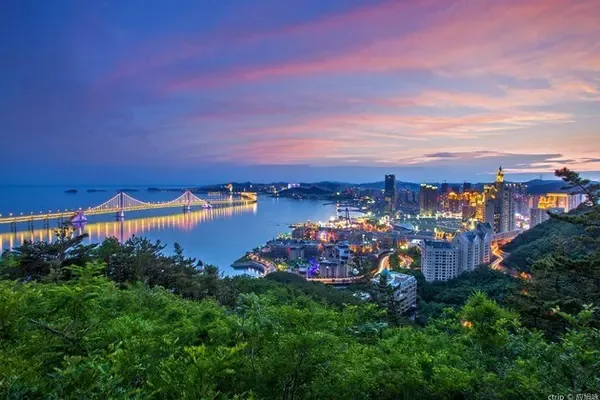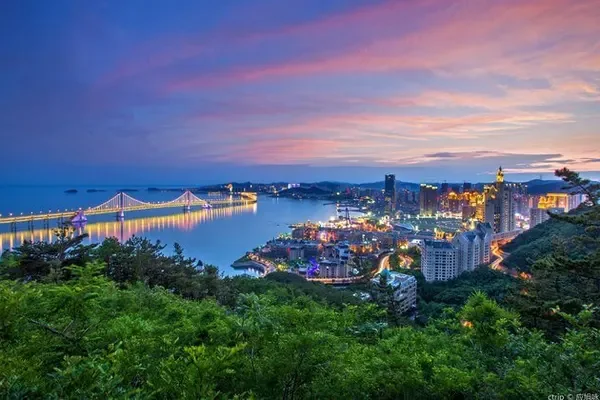From time to time, small oases flashed under the wings, which were very conspicuous in the large yellow desert. When I saw small oases gradually splicing into a big green carpet, I knew that Yinchuan had arrived.
A sister from a dormitory in the university came to pick me up from the airport and took me directly to live in her home in Yuehai Wanjia in Jinfeng District. After eating in Dayue City, I walked to digest my food while admiring the night view of Yinchuan. Unexpectedly, Yinchuan has changed so much in the past few years. There are many high-rise buildings, wide streets, clean and orderly, especially the beautiful night view, as if you are in a big city, like a small Shanghai.
Night view of the newly built Fenghuang Bridge on Fenghuang North Street, Yinchuan
My classmate Jiao is a teacher. This year, I am leading the graduating class of the sixth grade elementary school. He is busy with work and attends classes during the day. The first stop of his Ningxia tour is to go to the royal tombs of Xixia. Jiao asked me about the location of the through train to Xixia Royal Tombs. I packed up and set off early in the morning, and chatted with the driver in the taxi. The master told me that the Western Xia Royal Tomb is on Helan Mountain, on the west side of the city, closer to the departure point of the train station, so I took a taxi for 18 yuan and went to the tourist distribution center of the train station. There are many buses parked in the parking lot. There are more than 50 hotels around Macrolink, so it is very convenient to live here to go to the scenic spots. Most of the tourists who take the bus live in nearby hotels. See the color page of the exhibition rack. This is the largest and most professional hotel in Ningxia. It is a tourist distribution center with national chain operation. The direct train of Ningxia tourist attractions provides convenient transportation for independent tourists and friends to the scenic spots. The staff wearing yellow vests are very warm and welcoming. The one-way fare is 15 yuan per person. Because we arrived early, we turned around to the commercial food street, and then the guide on the bus called us to get on the bus.
The bus left the city quickly and headed westward. The roads in Ningxia also reveal a Northwest-style roughness and atmosphere, wide and straight. The tour guide said that the Western Xia Royal Mausoleum is at the foot of Helan Mountain, and pointed to a black spot on the horizon and said that it was Helan Mountain. I know Helan Mountain after reading Yue Fei's magnificent song "Man Jianghong". The mountain is getting closer and closer, and the mountain is like a black dragon, galloping and roaring, going from south to north without seeing the end.
The explanation on the car was given as a gift, but the yellow vest did not deal with it. It explained the history of Xixia vividly and vividly, which can be summed up as one. The establishment and territory of the Xixia Kingdom: In 1038 AD, Li Yuanhao, the leader of the Dangxiang clan, established the country in Xingqingfu (today's Yinchuan City) and proclaimed himself emperor. Founded the Xixia script; called the Great Xia Kingdom, because it is located in the northwest of the motherland and west of the Yellow River, so it is called Xixia for short. The so-called Ningxia means to pacify Xixia and make it peaceful forever. The Xixia Kingdom was established for 189 years, which was longer than the Southern Song Dynasty + Northern Song Dynasty, and it was a rival to the Song Dynasty. Gold and iron horse, the momentum is like a rainbow. In its heyday, the territory was tens of thousands of miles (its scope included today's Gansu, Ningxia, Inner Mongolia's Ordos and a small part of Alashan, Shaanxi, and Qinghai, with an area of about 850,000 square kilometers, which is nearly 13 times the total area of Ningxia today at 66,400 square kilometers ) first with the Northern Song Dynasty and Liao Kingdom, and later with the Southern Song Dynasty and the Jin Kingdom, "one-third of the world occupies one, and the male occupies the northwest for two hundred years". 2. The demise of Xixia; it was later destroyed by Genghis Khan's Mongolian cavalry. Genghis Khan swept across the Eurasian continent and was invincible, but he failed to attack Xixia 6 times. In June, he left Liupan Mountain and continued southward. bite). In July, Genghis Khan died of illness. Last words: Don't mourn in secret, don't let the enemy know; when Zhongxing Mansion is captured, immediately kill the king of Xixia and all the residents in the city. Zhongxing Mansion was besieged by the Mongolian army for half a year. There was no food and grass inside, no reinforcements outside, and a strong earthquake occurred again. The houses collapsed and suffered heavy casualties. He was executed by the Mongolian army immediately after surrendering the city. After the Mongolian army entered the city, they began to massacre the city. The Tuoba clan of the Xixia royal family (later given the surname Li by the Li Tang court) was basically slaughtered, and the soldiers and civilians in the city were also slaughtered. , was not killed. However, the Mongolian army did not give up, but plundered, burned, killed and looted wantonly. There were ruins everywhere in Xixia territory, and bones covered the fields. The Mongolian army also destroyed the tombs of the Xixia kings in order to eliminate their "dragon veins". Suffering from this catastrophe, the party members completely disappeared in the depths of history. The Xixia Kingdom, which had survived tenaciously for 190 years in the gap between the three powers of Song, Jin, and Mongolia, died so far (1227).
3. Mention the discovery of the Western Xia Royal Tomb: In June 1972, a certain unit of the Lanzhou Military Region built a small military airfield at the foot of Helan Mountain in Ningxia (you can see the Lankong Army when passing by the west of Beijing Road). Ten days later, when several soldiers were excavating the foundation of the project, they accidentally dug out more than a dozen pieces of ancient pottery. Among them were several broken clay pots, and some more regular-shaped square bricks. After seeing it, the head of the army ordered the soldiers to stop the engineering excavation immediately, and quickly reported the situation to the Ningxia Museum. Archaeologists from Ningxia Museum came to the project site 40 kilometers away from Yinchuan City, made necessary arrangements for the protection of the site, and started rescue excavation at the same time. Some exquisite murals such as warrior statues were found in the tomb. At the same time, some ancient exquisite handicrafts and pottery products such as square bricks were unearthed. The square bricks are covered with square characters and patterns. It is determined that this is a mausoleum of the ancient Xixia period. Archaeologists found 15 mausoleums with tall and large tombs here, and numbered them for the first time according to the order of investigation, and finally determined that these majestic buildings are the royal mausoleums of Xixia. When the Chinese Cultural Heritage Administration conducted archaeological excavations on them, it was determined that this was the tomb of the Xixia King that had disappeared in history. However, since all the tombs were robbed and the buildings on the ground were deliberately smashed and destroyed, who the owners of these tombs are? Forever a mystery. The mausoleum area is about 5 kilometers wide from east to west, more than 10 kilometers long from north to south, and has a total area of more than 50 square kilometers. As of 1999, a total of 9 imperial tombs and 253 burial tombs have been discovered. Mausoleum is quite. Experts confirmed that there are still some undiscovered ones and many have disappeared due to natural factors such as Helan Mountain torrents, so the real number should be more. Such a large royal cemetery is rare in China. On the precise coordinate map, people were also surprised to find that the nine imperial mausoleums form a pattern of the Big Dipper, and the tombs buried with them are also arranged according to the astrological layout. Archaeologists have discovered some very precious Xixia cultural relics. These cultural relics include Xixia characters, paintings reflecting the nomadic and market life of Xixia people, and various sculptures, including "Kaiyuan Tongbao", "Chunhua Tongbao", "Zhidao Tongbao", "Tianxi Tongbao" ", "Daguan Tongbao" and other coins in circulation in various periods, there are various cultural relics such as bronze wares and pottery chess pieces. A large number of unique stone carvings and clay sculptures were unearthed. The discovery of these cultural relics provides valuable objects for the study of Xixia civilization. Xixia Mausoleum, as a national key cultural relic protection unit, has been included in China’s preliminary list of world cultural heritage declarations. In order to better protect and display this precious historical and cultural heritage, Xixia Mausoleum National Archaeological Site Park has been in operation since the opening of the new Xixia Museum , a real-name system will be implemented to purchase tickets to enter the park.
At present, the application for world heritage is being promoted, focusing on planning and developing Xixia cultural tourism experience projects, designing and producing cultural and creative products, and further promoting the integrated development of culture and tourism through project experience and themed movie viewing. The scenic spot spent tens of millions of dollars to create a 3D themed movie "Dream of Xixia Love" and an immersive experience 4D fantasy movie "Fantasy Journey to the Underground Palace of Xixia", directed by the famous director Jin Tiemu. Western Xia stories.
Exterior of the newly renovated Xixia Museum
If you want to visit the Xixia King's Tomb, you must listen carefully to the explanation of the museum guide, which is professional enough. There are 3D and 4D movies in it, but after all, I still have a general understanding of the history, culture and changes of Xixia Kingdom. It is because I listened too seriously that I took a few photos less. The exhibits in the collection are exceptionally beautiful.
The treasure of the museum, the gilt copper bull
melody bird
Seated Avalokitesvara
Portrait Monument
unearthed stone horse
glass owl kiss
Mysterious Xixia characters (more strokes than strokes, the most strokes are more than 40 strokes)
3D Movie Xixia Love
4D underground palace fantasy tour
Cultural and Creative Theme Block
Students experience wooden movable type printing
Head portrait of the founding emperor Li Yuanhao
Going north after leaving the museum, at the end of the long tomb passage, there stands a tall, pyramid-shaped mound. Under the mound lies Li Yuanhao, the founding emperor of the Xixia Kingdom and a generation of heroes.
The main mausoleum currently open in the scenic area is Mausoleum No. 3 - the mausoleum of Li Yuanhao, the founding emperor of Xixia. The scenic spot is very large, about 13km, and you need to take a battery sightseeing car to browse the Xixia Museum and the No. 1, No. 2, and No. 3 Tombs in the field.
The picture below is a sand table model made according to the scale, copying the appearance of No. 3 Mausoleum before it was destroyed and the comparison picture we see now
Walking in this huge ruined cemetery, I feel a sense of desolation for no reason, and a feeling of nostalgia for the past spontaneously arises. Thinking back more than 900 years ago, on this land, a kingdom of the party of ethnic minorities once rose. Unwilling to surrender, the talented and bold Li Yuanhao proclaimed himself emperor in Xingqing Mansion (now Yinchuan City) in 1038. It encouraged farming, excavated water conservancy, and made immortal contributions to the development of western China. It respects Confucius and Confucianism, actively absorbs the nutrition of Han culture, creates its own characters, formulates its own laws and etiquette systems, and creates a splendid Xixia culture.
However, what is puzzling is that such a foreign regime that once dominated one side could not be found in the Twenty-Four Histories, as if it never existed at all. I remember that behind the Xinhua dictionary I used when I was a child, there was a chronology of Chinese history, and there was indeed no Xixia Kingdom in it. Such a ethnic minority Party group who created the splendid Xixia civilization neither knew where they came from when the country was founded, nor where they went after the country was subjugated. The Xixia civilization they created also seemed to be submerged by the billowing yellow sand, leaving no trace at all.
What is reassuring is that in modern times, especially after the founding of New China, systematic excavations, researches and protections have been carried out on this ethnic minority with glorious culture and the Xixia Dynasty established by them. However, due to the long history, frequent wars, natural disasters and man-made disasters, the cultural relics of Xixia have been completely destroyed. It seems that it is difficult to complete this gap in the Chinese annals, and it seems that there is no time in sight. It is said that only a few people in the world can understand this Xixia script, which is very similar to Chinese characters, and it is almost a dead script.
Of course, in addition to visiting museums and watching movies, there are also leisure activities such as practicing Xixia Wenmu movable type printing, riding the No. A series of postcards, booklets, key chains, refrigerator magnets, bookmarks, luggage tags and other unique cultural and creative gifts with Western Xia elements will also become travel symbols that tourists can take away.
Xixia, this hasty passer-by in the long river of Chinese history, is gradually drifting away from us. That mysterious nation, the mysterious country, is still covered with a thick veil, people are not allowed to get close, leaving only a few barren hills for people to pay tribute to.
The wind and rain of Xixia, the party's elegy.



